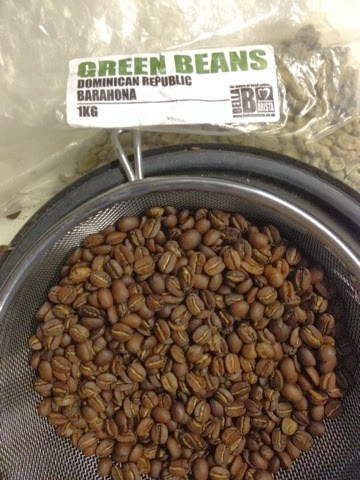Pronto
The third and last coffee from Strandvejsristeriet is called Pronto.
This is a blend containing Robusta. Not something that's common in these days with light roasts. I've heard many good things about this blend on our Danish coffee community Espressobar.
Many people has an opinion about robusta, mainly because it's used for discount coffee and it's very bitter.
But what many seems to forget, is that also high quality Robusta is produced by micro lots with great passion, not only minding profit.
A gentle and well considered amount of robusta, in a blend, can be very very tasty. Especially if the consumer enjoy milk in their espresso. Luckily I fit that description, and that's why I look forward to this blend.
Strandvejsristeriet describes it as sweet and fat, suitable as straight espresso or cortado.
Pronto contains 15% high quality Indian Robusta, and 85% arabica.
It's a lovely dark roast, and the smell is pleasant, the characteristic smell of Robusta, rubber'ish, is also present, but not in a way that makes it bad.
I'm a little gentle with the dosage, expecting it to be strong and powerful. I dose 16 grams trying to hit 25 grams of espresso in 25-30 sec.
After dialing it in which required a few shots, because it's a bit darker than my last bean, it ran very good, didn't see blonding at all actually.
It's a very heavy espresso, super rich and lots of crema. As I assumed its a strong one. The flavors that come to mind is, chocolate, almonds and more chocolate. Last but not least sweet ! It's a well balanced blend, especially considering the robusta. Not drinking much straight espresso, it's a tad strong for me. A little like a high percentage special brew ale. I love the taste, but when I'm half way thru the taste is too overwhelming. Luxury problems i call it.
It's a long time since I've had an WAUW feeling with espresso, but Pronto as a cappa sure made my day. A superb balance between the taste of coffee and hot chocolate is what I got. The strong coffee and robusta cuts right thru the milk and blends in with perfection. Did the suggested Cortado as well, and it was good but still a little too strong for me. But that's a matter of opinion and taste.
The main thing about this blend is, that Strandvejsristeriet has made a statement, trying to compete with Brazil based blends. And they have indeed succeeded. My biggest recommendations to Pronto, and Strandvejsristeriet in general. What I have seen and tasted is a convincing handling and distribution of quality roasts.
Once again we thank Strandvejsristeriet for giving us the opportunity to review their coffee.
Pronto can be purchased at






















.JPG)
.JPG)


















